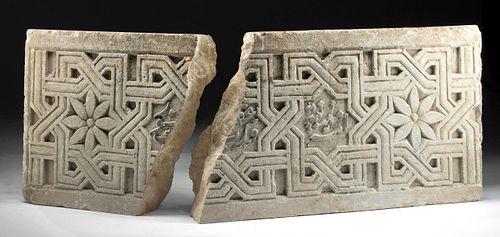Large 12th C. Islamic Marble Relief Panel
Lot 109
About Seller
Artemis Gallery
686 S Taylor Ave, Ste 106
Louisville, CO 80027
United States
Selling antiquities, ancient and ethnographic art online since 1993, Artemis Gallery specializes in Classical Antiquities (Egyptian, Greek, Roman, Near Eastern), Asian, Pre-Columbian, African / Tribal / Oceanographic art. Our extensive inventory includes pottery, stone, metal, wood, glass and textil...Read more
Estimate:
$7,000 - $10,500
Absentee vs Live bid
Two ways to bid:
- Leave a max absentee bid and the platform will bid on your behalf up to your maximum bid during the live auction.
- Bid live during the auction and your bids will be submitted real-time to the auctioneer.
Bid Increments
| Price | Bid Increment |
|---|---|
| $0 | $25 |
| $300 | $50 |
| $1,000 | $100 |
| $2,000 | $250 |
| $5,000 | $500 |
| $10,000 | $1,000 |
| $20,000 | $2,500 |
| $50,000 | $5,000 |
| $100,000 | $10,000 |
| $200,000 | $20,000 |
About Auction
By Artemis Gallery
Oct 7, 2021
Set Reminder
2021-10-07 10:00:00
2021-10-07 10:00:00
America/New_York
Bidsquare
Bidsquare : Exceptional Antiquities Ethnographic Fine Art
https://www.bidsquare.com/auctions/artemis-gallery/exceptional-antiquities-ethnographic-fine-art-7537
Museum-worthy examples of Egyptian, Greek, Roman, Etruscan, Near Eastern, Far East / Asian, Pre-Columbian, African / Tribal, Oceanic, Native American, Spanish Colonial, Fossils, Ancient Jewelry, Fine / Visual Arts, so much more! Artemis Gallery info@artemisgallery.com
Museum-worthy examples of Egyptian, Greek, Roman, Etruscan, Near Eastern, Far East / Asian, Pre-Columbian, African / Tribal, Oceanic, Native American, Spanish Colonial, Fossils, Ancient Jewelry, Fine / Visual Arts, so much more! Artemis Gallery info@artemisgallery.com
- Lot Description
Near East, Islamic culture, possibly Mamluk Sultanate or Seljuk Empire, ca. 12th to 16th century. A stunning marble wall panel, perhaps intended to serve as a dado, of rectangular form, skillfully hand-sculpted with a mesmerizing relief of both geometric and floral elements on one side. The gorgeous carving is comprised of an arabesque scrolling pattern that twists and turns in an Escher-esque manner to form a pattern of regular tessellation. This pattern features a series of 4 eight-pointed star motifs, all lined horizontally and adorned with interior decorations - the 2 outer stars each exhibiting an 8-petalled flower and the other 2 stars containing characters of Arabic script. Note the nice remains of black pigment embellishing the Arabic writing. Size (of larger piece): 33" L x 6.3" W x 19.5" H (83.8 cm x 16 cm x 49.5 cm); Size (of smaller piece): 21.7" L x 6" W x 19.5" H (55.1 cm x 15.2 cm x 49.5 cm)
According to the Department of Islamic Art at the Metropolitan Museum of Art, "Geometric patterns make up one of the three nonfigural types of decoration in Islamic art, which also include calligraphy and vegetal patterns. Whether isolated or used in combination with nonfigural ornamentation or figural representation, geometric patterns are popularly associated with Islamic art, largely due to their aniconic quality. These abstract designs not only adorn the surfaces of monumental Islamic architecture but also function as the major decorative element on a vast array of objects of all types. While geometric ornamentation may have reached a pinnacle in the Islamic world, the sources for both the shapes and the intricate patterns already existed in late antiquity among the Greeks, Romans, and Sasanians in Iran. Islamic artists appropriated key elements from the classical tradition, then complicated and elaborated upon them in order to invent a new form of decoration that stressed the importance of unity and order. The significant intellectual contributions of Islamic mathematicians, astronomers, and scientists were essential to the creation of this unique new style."
This piece has been searched against the Art Loss Register database and has been cleared. The Art Loss Register maintains the world's largest database of stolen art, collectibles, and antiques.
Provenance: private East Coast, USA collection, collected prior to 2004
All items legal to buy/sell under U.S. Statute covering cultural patrimony Code 2600, CHAPTER 14, and are guaranteed to be as described or your money back.
A Certificate of Authenticity will accompany all winning bids.
PLEASE NOTE: Due to recent increases of shipments being seized by Australian & German customs (even for items with pre-UNESCO provenance), we will no longer ship most antiquities and ancient Chinese art to Australia & Germany. For categories of items that are acceptable to ship to Australia or Germany, please contact us directly or work with your local customs brokerage firm.
Display stands not described as included/custom in the item description are for photography purposes only and will not be included with the item upon shipping.
#146680Split into 2 pieces as shown. Expected nicks, chips, and abrasions throughout, all commensurate with age. Otherwise, very nice with liberal remains of black pigment.Condition
- Shipping Info
-
All shipping is handled in-house for your convenience. Your invoice from Artemis Gallery will include shipping calculation instructions. If in doubt, please inquire BEFORE bidding for estimated shipping costs for individual items.
-
- Buyer's Premium



 EUR
EUR CAD
CAD AUD
AUD GBP
GBP MXN
MXN HKD
HKD CNY
CNY MYR
MYR SEK
SEK SGD
SGD CHF
CHF THB
THB
















